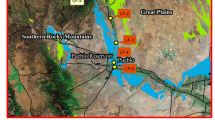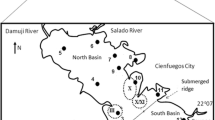Abstract
Concentrations of selenium and other trace elements were determined in 55 whole body samples of juvenile anadromous striped bass (Morone saxatilis) from the San Joaquin Valley and San Francisco Estuary, California. The fish (≤1 yr old—the predominant life stage in the San Joaquin Valley) were collected in September–December 1986 from 19 sites in the Valley and 3 sites in the Estuary, and analyzed for the following elements: aluminum (Al), arsenic (As), boron (B), barium (Ba), beryllium (Be), cadmium (Cd), chromium (Cr), copper (Cu), iron (Fe), mercury (Hg), magnesium (Mg), molybdenum (Mo), nickel (Ni), lead (Pb), selenium (Se), strontium (Sr), vanadium (V), and zinc (Zn). When compared to concentrations in whole freshwater fish measured by surveys from other waters, a few samples contained higher levels, of As, Cd, Cu, Pb, and Se. The median concentrations of Al, As, Cu, Fe, Mg, Se, and Sr also differed significantly (P⩽0.05) among sites. However, only Se concentrations were highest (up to 7.9 μg/g dry weight) in samples from Valley sites exposed to agricultural subsurface (tile) drainwater; concentrations were lower in samples collected elsewhere. Water quality variables—especially those strongly influenced by tile drainwater (conductivity, total dissolved solids, total alkalinity, and total hardness)—were also significantly correlated (P⩽0.05) with Se concentrations in fish. Selenium concentrations in striped bass from the Estuary were only one-fourth to one-half the concentrations measured in the most contaminated fish from the San Joaquin River.
Similar content being viewed by others
References
Agee BA (1986) Toxic substances monitoring program 1984. California State Water Resources Control Board, Water Quality Monitoring Report No 86-4WQ, Sacramento, CA, 116 pp + Appendices
Bagenal TB, Tesch FW (1978) Age and growth. In: Bagenal T (ed) Methods for assessment of fish production in fresh waters. Blackwell Scientific Publications, Oxford, pp 101–136
Brumbaugh WG, Kane DA (1985) Variability of aluminum concentrations in organs and whole bodies of smallmouth bass (Micropterus dolomieui). Environ Sci Technol 19:828–831
Cooper JJ, Vigg S (1984) Extreme mercury concentrations of a striped bass,Morone saxatilis, with a known residence time in Lahontan Reservoir, Nevada. Calif Fish Game 70:190–192
Deverel SJ, Gilliom RJ, Fujii R, Izbicki JA, Fields JC (1984) Areal distribution of selenium and other inorganic constituents in shallow ground water of the San Luis Drain Service Area, San Joaquin Valley, California: A preliminary study. US Geol Surv, Water-Resour Inves Rep 84-4319, Sacramento, CA, 67 pp
Eisler R (1985) Cadmium hazards to fish, wildlife, and invertebrates: A synoptic review. US Fish Wildl Serv, Biol Rep 85 (1.2), 46 pp
- (1986) Chromium hazards to fish, wildlife, and invertebrates: A synoptic review. US Fish Wildl Serv Biol Rep 85 (1.6), 60 pp
- (1987) Mercury hazards to fish, wildlife, and invertebrates: A synoptic review. US Fish Wildl Serv Biol Rep 85 (1.10), 90 pp
- (1988) Arsenic hazards to fish, wildlife, and invertebrates: A synoptic review. US Fish Wildl Serv Biol Rep 85 (1.12), 92 pp
Giesey JP Jr, Wiener JG (1977) Frequency distribution of trace metal concentrations in five freshwater fishes. Trans Am Fish Soc 106:393–403
Gillespie RB, Baumann PC (1986) Effects of high tissue concentrations of selenium on reproduction by bluegills. Trans Am Fish Soc 115:208–213
Gilliom RJ (1986) Selected water-quality data for the San Joaquin River and its tributaries, California, June to September 1985. US Geol Surv, Open-File Rep 86-74, Sacramento, CA, 12 pp
Gough LP, Shacklette HT, Case AA (1979) Element concentrations toxic to plants, animals, and man. US Geol Surv, Bull 1466, Washington, DC, 80 pp
Greenberg AJ, Kopec D (1986) Decline of Bay-Delta fisheries and increased selenium loading: Possible correlation? In: Selenium and agricultural drainage: Implications for San Francisco Bay and the California environment. The Bay Institute of San Francisco, Tiburon, CA, pp 69–81
Haines TA, Jagoe CH, Dwyer FJ, Buckler DR (1988) Relation of trace metal body burdens and gill damage in fish to surface water acidification from atmospheric deposition. In: Ryans RC (ed) Fate and effects of pollutants on aquatic organisms and ecosystems: Proceedings of USA-USSR symposium, Athens, Georgia. US Environ Protect Agency, EPA 600/9-88/001, Athens, GA, pp 90–104
Haseltine SD, Heinz GH, Reichel WL, Moore JF (1981) Organochlorine and metal residues in eggs of waterfowl nesting on islands in Lake Michigan off Door County, Wisconsin. Pestic Monit J 15:90–97
Hatch WR, Ott WL (1968) Determination of submicrogram quantities of mercury by atomic absorption spectrophotometry. Anal Chem 40:2085–2087
Jenkins DW (1980) Nickel accumulation in aquatic biota. In: Nriagu JO (ed) Nickel in the environment. John Wiley & Sons, New York, pp 283–337
Knudsen DL, Kohlhorst DW (1987) Striped bass health index monitoring: 1985 final report. Report of the California Department of Fish and Game to the State Water Resources Control Board, Sacramento, CA, 31 pp + Appendices A-M
Krynitsky AJ (1987) Preparation of biological tissue for determination of arsenic and selenium by graphite furnace atomic absorption spectrometry. Anal Chem 59:1884–1886
Lemly AD (1985) Toxicology of selenium in a freshwater reservoir: Implications for environmental hazard evaluation and safety. Ecotoxicol Environ Safety 10:314–338
Lemly AD, Smith GJ (1987) Aquatic cycling of selenium: Implications for fish and wildlife. US Department of the Interior, Fish and Wildlife Leaflet 12, Washington, DC, 10 pp
Lowe TP, May TW, Brumbaugh WG, Kane DA (1985) National Contaminant Biomonitoring Program: Concentrations of seven elements in freshwater fish, 1978–1981, Arch Environ Contam Toxicol 14:363–388
May TW, McKinney GL (1981) Cadmium, lead, mercury, arsenic, and selenium concentrations in freshwater fish, 1976–77—National Pesticide Monitoring Program. Pestic Monit J 15:14–38
Mehrle PM, Haines TA, Hamilton S, Ludke JL, Mayer FL, Ribick MA (1982) Relationship between body contaminants and bone development in East-coast striped bass. Trans Am Fish Soc 111:231–241
Monk HE (1961) Recommended methods of analysis of pesticide residues in foodstuffs. Report by the Joint Mercury Residues Panel. The Analyst 86:608–614
Moore JW, Ramamoorthy S (1984) Heavy metals in natural waters. Springer-Verlag, New York, 268 pp
Moyle PB (1976) Inland Fishes of California. University of California Press, Berkeley, CA, 405 pp
Oladimeji AA, Qadri SU, DeFreitas ASW (1982) Effect of acclimation of rainbow trout (Salmo gairdneri) to arsenic on retention of a subsequent dose of arsenic. Ecotoxicol Environ Safety 6:196–203
Perkin Elmer Corporation (1985) Plasma II emission spectrometer. Vol 1–3
Phillips DJH (1980) Quantitative aquatic biological indicators. Applied Sciences Publ Ltd, London, 488 pp
— (1988) Selenium in the San Francisco Estuary: An opportunity. Mar Pollut Bull 19:191–192
Phillips GR, Russo RC (1978) Metal bioaccumulation in fishes and aquatic invertebrates: A literature review. US Environ Protect Agency, EPA-600-78-103, Duluth, MN, 116 pp
Presser TS, Barnes I (1985) Dissolved constituents including selenium in waters in the vicinity of Kesterson National Wildlife Refuge and the west Grassland, Fresno and Merced counties, California. US Geological Survey, Water Resources Investigations Report 85-4220, Menlo Park, CA, 73 pp
Radtke DB, Kepner WG, Effertz RJ (1988) Reconnaissance investigation of water quality, bottom sediment, and biota associated with irrigation drainage in the Lower Colorado River Valley, Arizona, California, and Nevada, 1986–87. US Geol Surv, Water-Resour Inves Rep 88-4002, Tucson, AZ, 77 pp
Rasmussen D, Agee BA, Phillips PT (1987) Toxic substances monitoring program 1985. California State Water Resources Control Board, Water Quality Monitoring Report No 87-1WQ, Sacramento, CA, 51 pp. + Appendices
Saiki MK (1984) Environmental conditions and fish faunas in low elevation rivers on the irrigated San Joaquin Valley floor, California. Calif Fish Game 70:145–157
— (1986) A field example of selenium contamination in an aquatic food chain. In: Symposium on Selenium in the Environment. Publ No CAT1/860201, California Agricultural Technology Institute, California State University, Fresno, CA, pp 67–76
— (1989) Selenium and other trace elements in fish from the San Joaquin Valley and Suisun Bay, 1985. In: Howard AQ (ed) Selenium and Agricultural Drainage: Implications for San Francisco Bay and the California Environment (Selenium IV). The Bay Institute of San Francisco, Tiburon, CA, pp 35–49
Saiki MK, Lowe TP (1987) Selenium in aquatic organisms from subsurface agricultural drainage water, San Joaquin Valley, California. Arch Environ Contam Toxicol 16:657–670
Saiki MK, May TW (1988) Trace element residues in bluegills and common carp from the lower San Joaquin River, California, and its tributaries. Sci Total Environ 74:199–217
San Joaquin Valley Interagency Drainage Program (1979) Agricultural drainage and salt management in the San Joaquin Valley. Fresno, CA
Schmitt CJ, Finger SE (1987) The effects of sample preparation on measured concentrations of eight elements in edible tissues of fish from streams contaminated by lead mining. Arch Environ Contam Toxicol 16:185–207
Schroeder RA, Palawski DU, Skorupa JP (1988) Reconnaissance investigation of water quality, bottom sediment, and biota associated with irrigation drainage in the Tulare Lake Bed area, southern San Joaquin Valley, California, 1986–87. US Geol Surv, Water-Resour Invest Rep 88-4001, Sacramento, CA, 86 pp
Sorenson SK (1982) Water quality assessment of the Merced River, California. US Geol Surv, Open-file Rep 82-450, Lakewood, CO, 46 pp or]Sorenson SK, Hoffman RJ (1981) Water-quality assessment of the Merced River, California, in the 1977 water year. US Geol Surv, Water Resour Invest Rep 80-75, Menlo Park, CA, 31 pp
State Water Resources Control Board (1987) Regulation of Agricultural Drainage to the San Joaquin River. Final Report. SWRCB Order No WQ 85-1, Technical Committee Report, Sacramento, CA
Stevens DE (1977) Striped bass (Morone saxatilis) year class strength in relation to river flow in the Sacramento-San Joaquin Estuary, California. Trans Am Fish Soc 106:34–42
Stevens DE, Kohlhorst DW, Miller LW, Kelley DW (1985) The decline of striped bass in the Sacramento-San Joaquin Estuary, California. Trans Am Fish Soc 114:12–30
Urquhart KAF, Knudsen DL (1988) Striped bass health index monitoring: 1986 final report. Report of the California Department of Fish and Game to the State Water Resources Control Board, Sacramento, CA, 55 pp + Appendices A-M
Whipple J, Eldridge M, Benville P, Bowers M, Jarvis B, Stapp N (1981) The effect of inherent parental factors on gamete condition and viability in striped bass (Morone saxatilis). Rapp R-v Reun Cons Int Explor Mer 178:93–94
White JR (1986) The striped bass sport fishery in the Sacramento-San Joaquin Estuary, 1969–1979. Calif Fish Game 72:17–37
White JR, Hofmann PS, Hammond D, Baumgartner S (1988) Selenium verification study 1986–1987. A report to the California State Water Resources Control Board. California Department of Fish and Game, Sacramento, CA, 60 pp + Appendices
Wiener JG, Jackson GA, May TW, Cole BP (1984) Longitudinal distribution of trace elements (As, Cd, Cr, Hg, Pb, and Se) in fishes and sediments in the upper Mississippi River. In: Wiener JG, Anderson RV, McConville DR (eds) Contaminants in the upper Mississippi River. Butterworth Publ, Stoneham, MA, pp 139–170
Author information
Authors and Affiliations
Rights and permissions
About this article
Cite this article
Saiki, M.K., Palawski, D.U. Selenium and other elements in juvenile striped bass from the San Joaquin Valley and San Francisco Estuary, California. Arch. Environ. Contam. Toxicol. 19, 717–730 (1990). https://doi.org/10.1007/BF01183990
Received:
Revised:
Issue Date:
DOI: https://doi.org/10.1007/BF01183990




